One would not normally expect a nation facing a protracted war on its territory to be sending its best troops overseas to help achieve peace elsewhere. But Ukraine does it.
Over the last 27 years, Ukraine has been a very eager participant in numerous peacekeeping operations led by the United Nations and NATO around the world.
Even now, despite fighting Russia for five years in its eastern Donbas region, Ukraine has hundreds of civilian and military specialists deployed to hot spots from Eastern Europe to Africa and the Middle East.
And it constantly seeks more missions for its soldiers.
The reason is rather pragmatic: Kyiv wants its brightest military officers to master and bring home the world’s best military practices that the nation desperately needs to continue resisting Russia.
Moreover, it wants to make Ukraine’s assistance in these operations even more important and irreplaceable for NATO, the defense alliance Kyiv desperately wants to join.
‘Good motivation’
Ukrainian soldiers put on their white-and-blue UN peacekeeper uniforms almost immediately after the country gained independence in 1991.
As early as mid-July 1992, Ukraine’s 240 Special Battalion deployed to Bosnia and saw fierce action right upon its arrival in Sarajevo, a city besieged by Serbian forces.
That was Ukraine’s very first overseas deployment. Since those days, nearly 45,000 Ukrainian troops have participated in 27 operations led by the UN and NATO, according to the General Staff of the Ukrainian Armed Forces. Fifty-five Ukrainian soldiers have been killed while serving as peacekeepers.
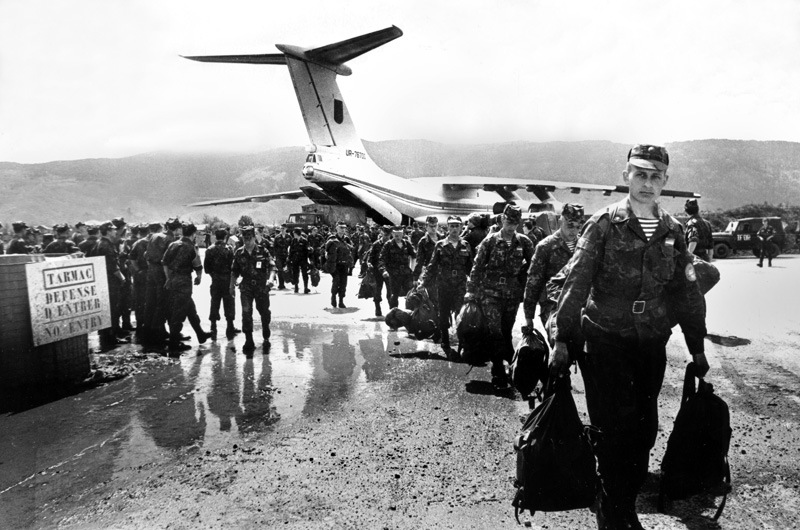
Ukrainian peacekeepers from the 240th Special Battalion arrive in the Sarajevo airport in May 1996. (Ukrinform)
The geography of Ukrainian involvement is extremely wide: The Balkans; African countries like Angola, Sierra Leone, Sudan, the Democratic Republic of the Congo, Liberia and Ivory Coast; and Asian countries like Iraq, Tajikistan, Lebanon, and Kuwait.
As the military experienced stagnation in the 1990s and early 2000s, many Ukrainian military servicepeople saw being deployed to an overseas mission as great luck — and a blessing for their professional growth.
“In the years before the war in Donbas erupted, that was basically the only way to gain real combat experience,” says Oleksandr Kosynskiy, the chief non-commissioned officer of Ukraine’s Armed Forces and a former member of Ukrainian missions to Sierra Leone (2001-2002) and Iraq (2004-2005).
Contracted service people “used to come home from their first mission only to start dreaming about a new one,” he told the Kyiv Post. The soldiers weren’t only motivated by money. They also wanted to go abroad and feel like their skills were in demand.
Putting on body armor and a peacekeeper’s helmet was an alternative to “doing routine mess duties, cleaning their bases and painting border stones white all the time,” Kosynskiy says.
“They lived for this, and this was good motivation.”
Still in action
Today, Ukraine’s involvement overseas is predictably less active amid the war in Donbas.
Still, 351 servicepersons (including three women) are now participating in nine operations led by the UN and NATO.
The largest Ukrainian contingent overseas is deployed to the Democratic Republic of the Congo as part of the UN’s MONUSCO peace support mission. Ukraine’s 250-strong 18th Helicopter Detachment is based in the airfields of Goma and Beni in the country’s east, which is ravaged by a never-ending standoff between the Congolese government and numerous local warlords fighting for control over extremely abundant and lucrative deposits of coltan, diamonds, and cobalt.
For decades, this struggle has gone hand-in-hand with atrocities against the civilian population amid catastrophically low levels of medical care and underdeveloped public infrastructure. Additionally, in July 2019, the World Health Organization declared an emergency in the major city of Goma due to an outbreak of the deadly Ebola virus disease.
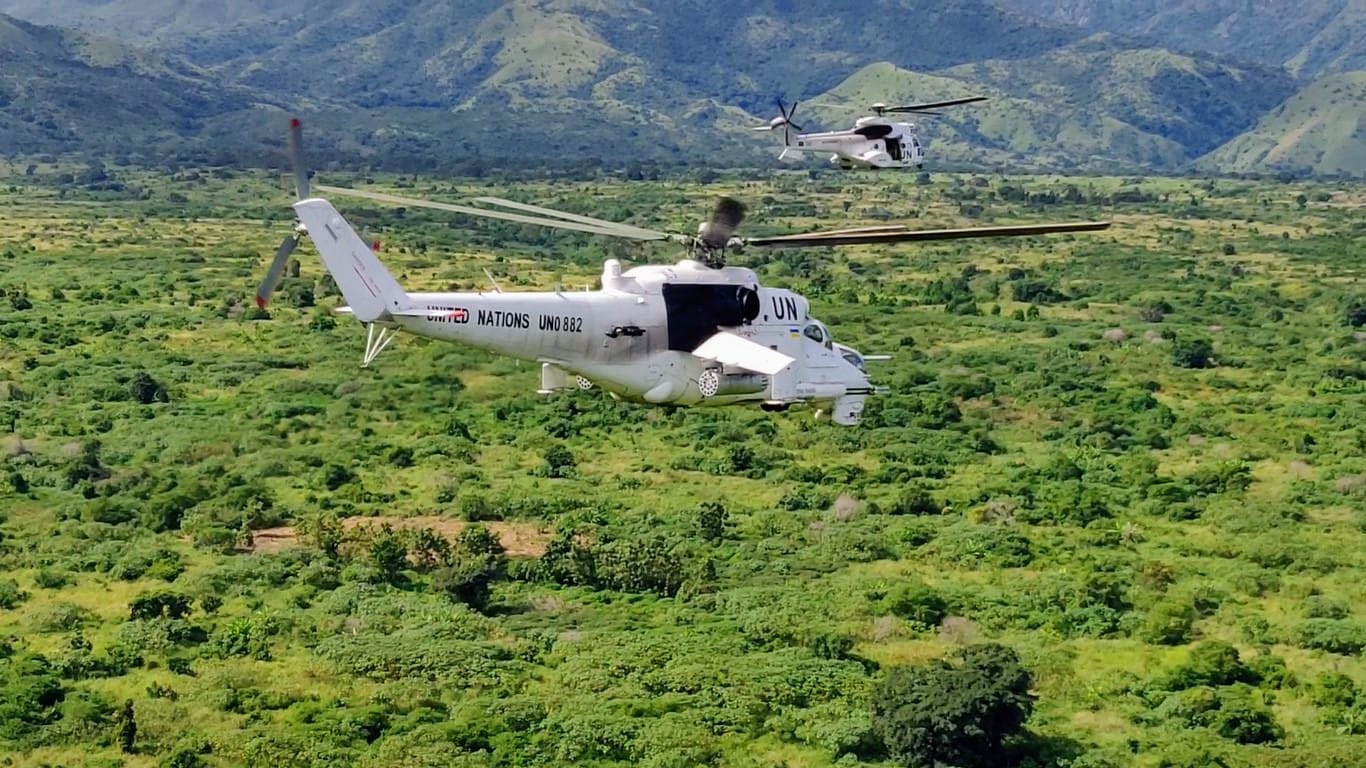
A Ukrainian Mil Mi-24 helicopters escort a South African TP-1 Oryx, part of United Nations’ MONUSCO mission on Oct. 21, 2019. (Vladyslav Demyanenko/Armed Forces of Ukraine )
In that area, Ukrainian forces operate 8 Mil Mi-8 and Mi-24 helicopters to ensure medical evacuations and transportation for UN medical personnel. Ukrainian strike helicopters also provide reconnaissance and firing support for UN troops protecting the civilian population from militant formations.
Another considerable Ukrainian contingent of 40 servicepeople is still working with the NATO-led KFOR mission in Kosovo. A team of Ukrainian military specialists ensures engineering support for KFOR forces and do landmine clearing in the area.
Moreover, by the end of 2019, 50 Ukrainian troops will join this contingent at NATO’s request, according to Ukraine’s General Staff.
Ukrainian military instructors, namely 21 servicepeople, are also still deployed to Afghanistan together with NATO’s advisory mission Resolute Support, aimed at training Afghan national armed forces facing a major standoff with Taliban forces, who threaten to retake the war-ravaged country.
By the end of 2019, more Ukrainian servicepeople may be deployed to Afghanistan, according to the General Staff.
In July, Ukraine added another country to its long list of peacekeeping engagements: Five Ukrainian specialists were deployed to Mali as part of the UN stabilization mission in a country still reeling from a 2012 Tuareg rebellion and threatened by al-Qaeda.

A Ukrainian 7th Mechanized Infantry Brigade officer plays with Iraqi children in the suburbs of the city of al Kut Apr. 23, 2005. (AFP)
More recently, the Defense Ministry confirmed Ukrainians will return to Iraq in the near future.
Back in 2004-2005, Ukraine sent a full-fledged, enhanced combined arms brigade to the country following the U.S.-led invasion in 2003. The Ukrainian contingent was mostly responsible for police actions in al-Kut province east of Baghdad, but was withdrawn after 18 soldiers were killed and over 40 were wounded in action.
According to Ukrainian Defense Minister Andriy Zahorodnuyk, negotiations regarding a new deployment are now in their final stage. Soon, up to 10 Ukrainian troops will join NATO’s recently-launched advisory mission in the Middle Eastern country.
On Nov. 1, Zahorodnyuk said that this would be a strictly non-combatant operation, with Ukrainian specialists consulting the Iraqi army on the maintenance of Soviet-era military hardware.
Other than that, Ukraine has a smaller presence in many other hotspots like South Sudan (four soldiers), Cyprus (one soldier), and Transnistria (10 military observers).
“By taking part in international peace support operations, Ukrainian military servicepeople, are enforcing Ukraine’s national interests,” says Colonel Valentyn Levchyk, deputy chief of the Directorate for Military Cooperation and Peacekeeping Operations at Ukraine’s General Staff.
“Thanks to their efforts, the country’s role and authority is growing stronger on the global scene.”
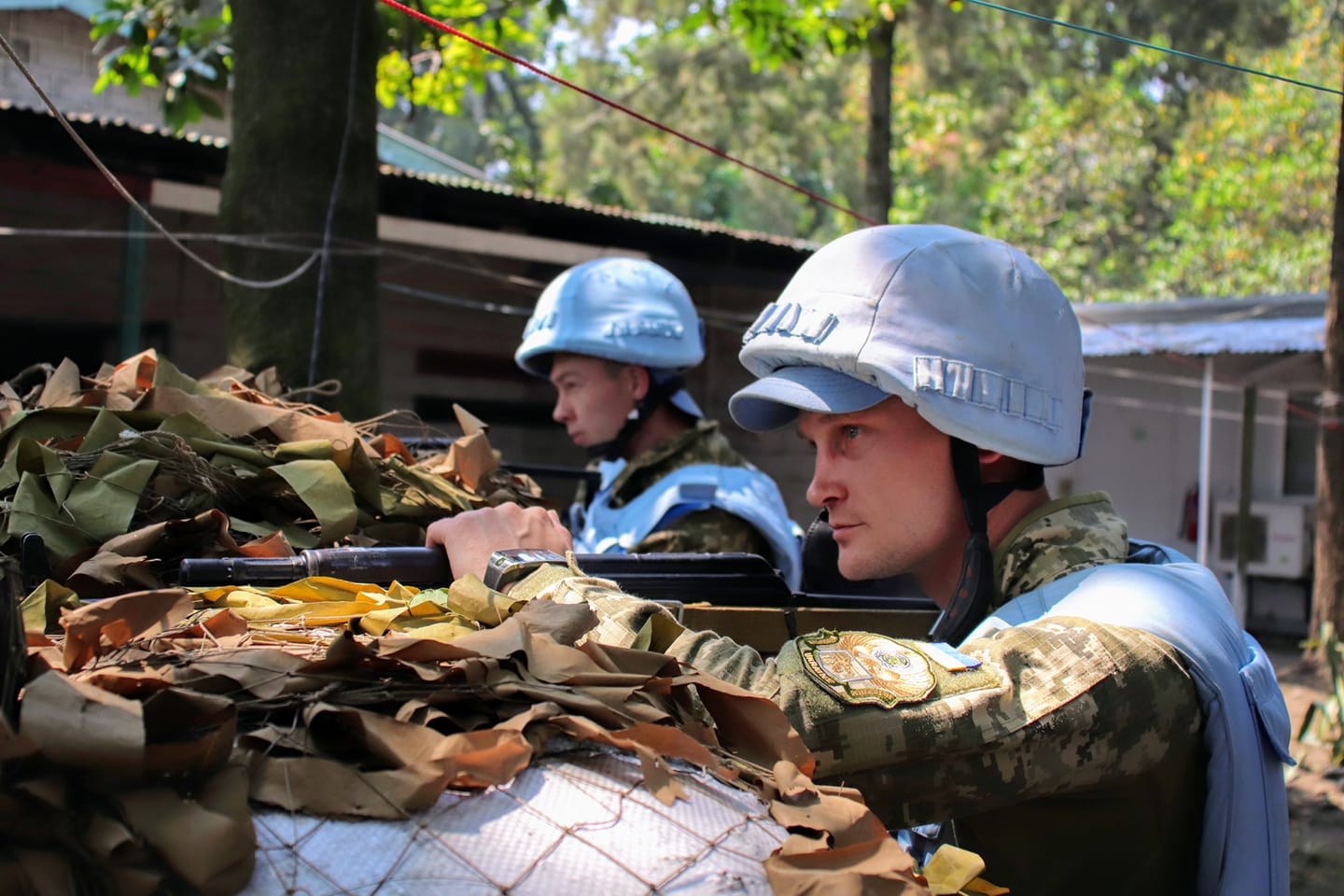
Ukrainian peacekeepers guard a United Nations base in the city of Goma on Aug. 12, 2019. (Vladyslav Demyanenko/Armed Forces of Ukraine )
Priceless experience
Other than conducting reconnaissance flight and airstrikes in Congo, the Ukrainian military are not currently engaged in overseas missions envisaging full-fledged combat engagements.
However, recently, combat formations recognized as the year’s best-performing have been given a chance to reward some of their most distinguished servicepeople with overseas deployments, particularly to Congo.
The opportunity to see another war and communicate with foreign military officers helps to motivate dedicated Ukrainian servicepeople to stay in the military. It is also priceless experience that should not be underestimated, says Kosynskiy.
He knows this from personal experience. In 2004-2005, Kosynskiy was deployed to Iraq, an experience that boosted his growth as a soldier. During that mission, he learned much about modern asymmetric warfare from his foreign colleagues.
“(In Iraq), we cooperated with American troops, such as U.S. Army Rangers,” Kosynskiy says. “I was a special task platoon leader, and I learned a lot from there — in terms of how to assault buildings or how to secure an area… We were also trained by Poland’s GROM special operations troops, and they gave us our early skills in close combat, escorting VIPs and so on.”
All those things were absolutely new for Ukrainian forces, who still largely held antiquated views toward soldiering — especially when it came to countering guerrilla warfare in Iraqi urban areas.
“This was not studied in Ukraine back then,” he continues.
“We mastered old Soviet tactics and never saw how things were done in modern warfare. No one knew how to move through a city, how to assign sectors of responsibility in combat units, how to cross road intersections, how to turn right or left, to react to grenade explosions and engagements from rooftops, how to carry out patrols in mountainous or forested grounds.”
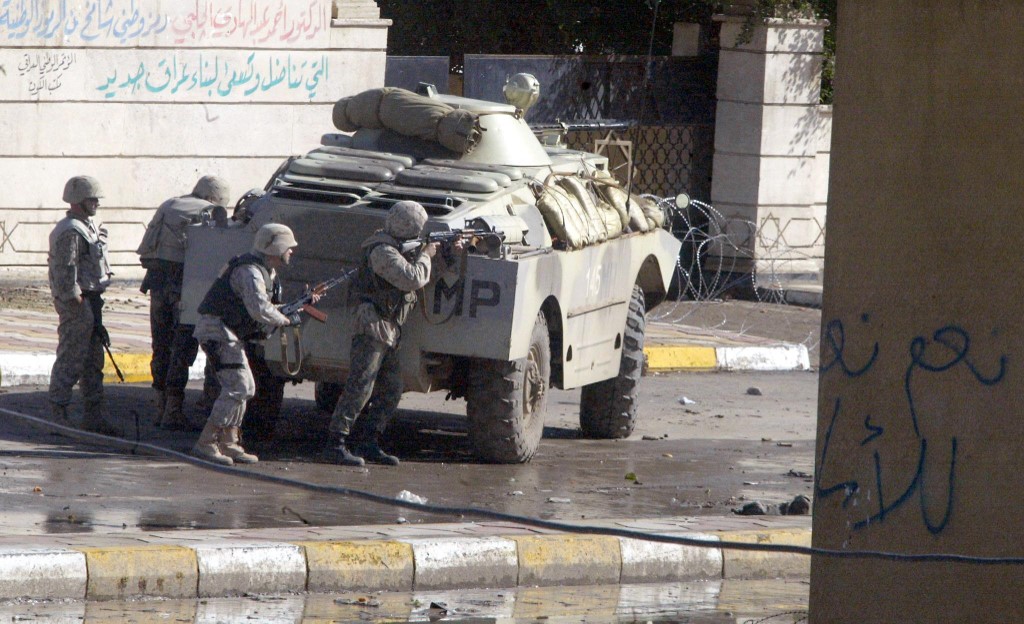
Ukrainian soldiers take shelter behind a military vehicle after Iraqi demonstrators threw grenades towards them in the southern city of Al Kut on Jan. 13, 2004. (AFP)
In al-Kut province, the Ukrainian troops often had to organize effective protection of giant convoys of 30-40 fuel tank trucks bound for Kuwait and escorted only by three armored personnel carriers.
“In Iraq, we learned how to do all those things,” Kosynskiy says.
A decade after Kosynskiy returned from the Middle East, these skills came into extremely high demand in Donbas — even though the World War II-style hostilities in eastern Ukraine were quite different from the urban guerrilla warfare of Iraq.
Iraq trained him well.
“Our bases were shelled with mortars several times, and I was prepared for this,” he says. “I met guys who had been to Iraq and then ended up in (Donbas), and it was much easier for them to adapt and understand what to do based on their Iraq experience.”
But there were also many more soldiers with no actual combat experience overseas. The difference between them and the former peacekeepers was striking.
“In Iraq, we knew for sure how to set up a checkpoint, how to dispense areas of engagement and prevent a checkpoint from being captured or destroyed, how to organize and check the traffic, how to work with the local population,” Kosynskiy says.
“Had this experience been put to use from the very start, it would have had a very positive influence upon our combat effectiveness.”
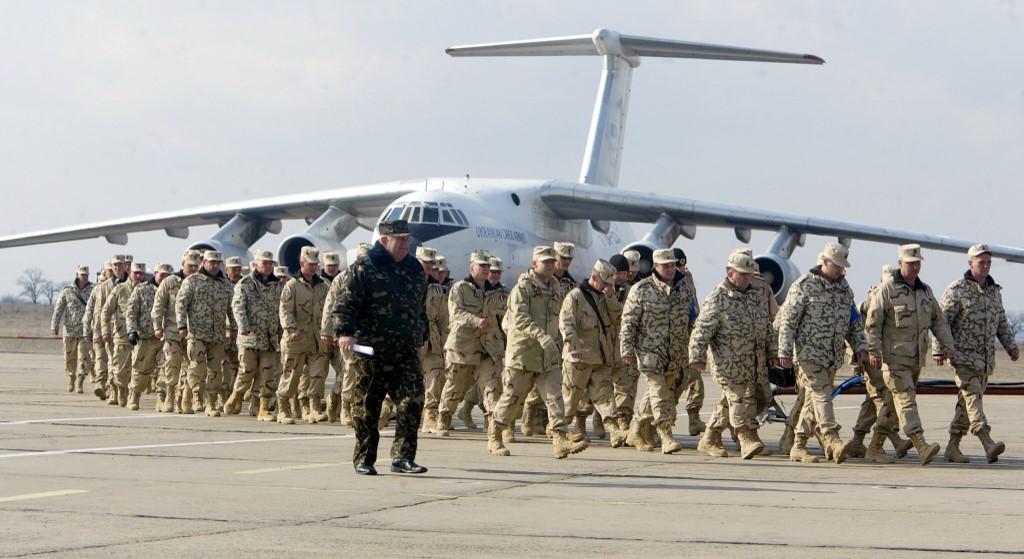
Ukrainian soldiers leave an Ilyushin Il-76 aircraft at the Mykolaiv airport on March 15, 2005, as Ukrainian forces withdraw from Iraq after a peace support mission launched in 2004. (AFP)
